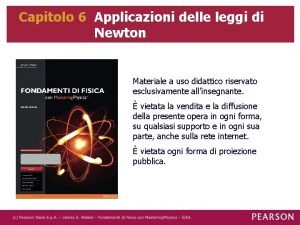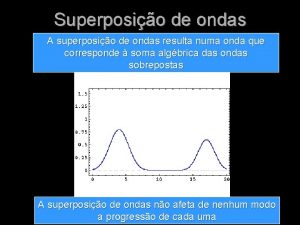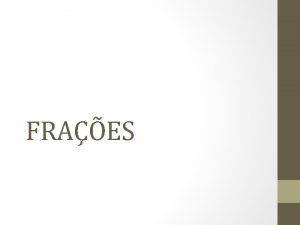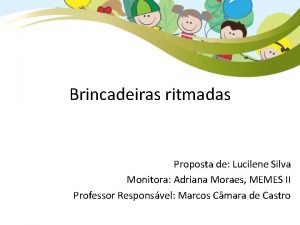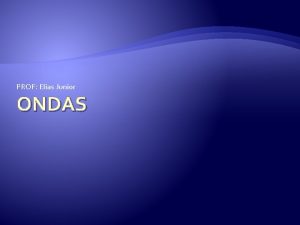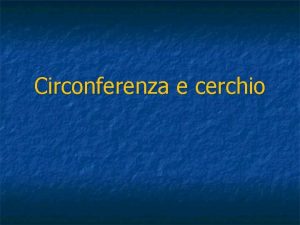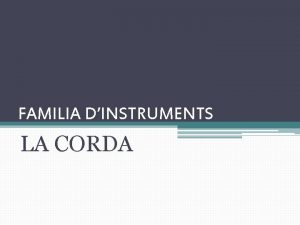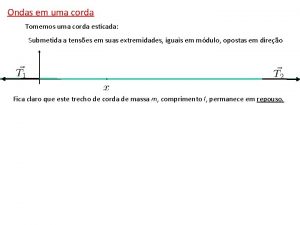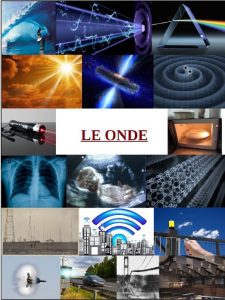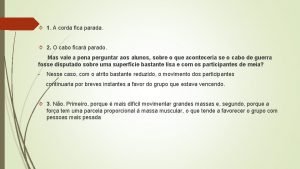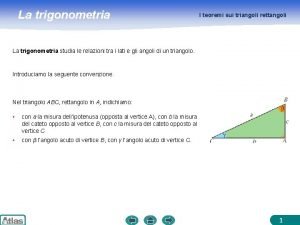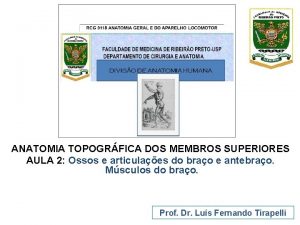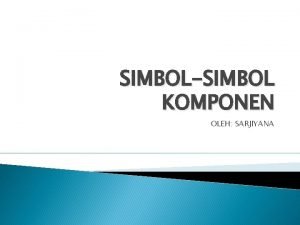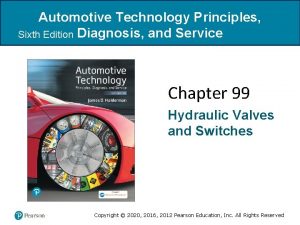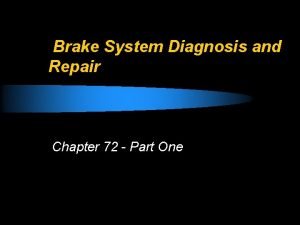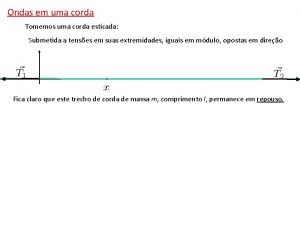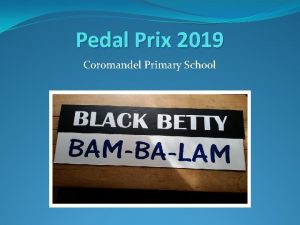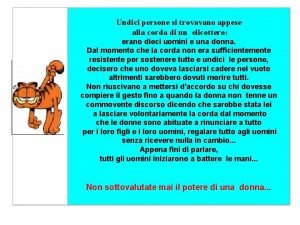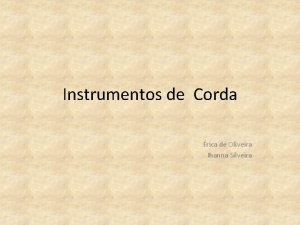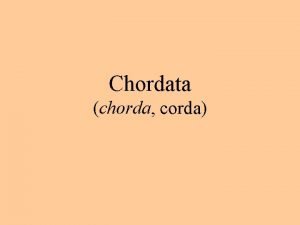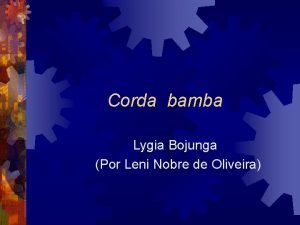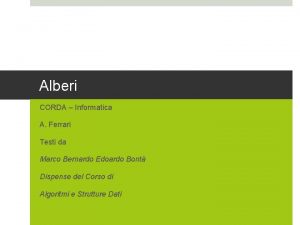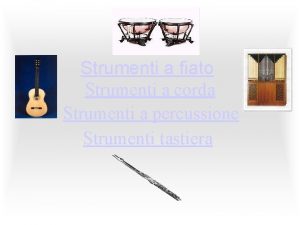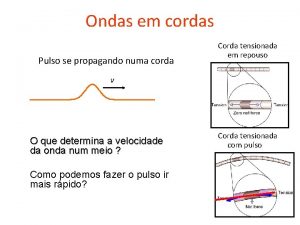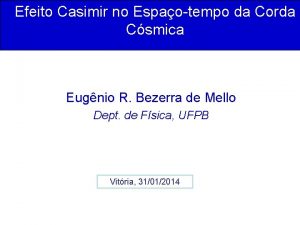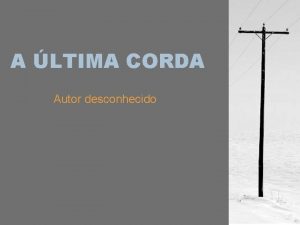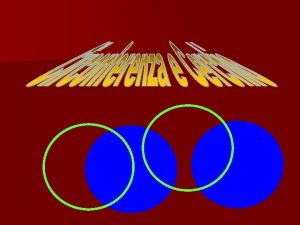The Effects of the Una Corda Pedal on























- Slides: 23

The Effects of the Una Corda Pedal on Harmonic Structure Danielle Castens Southern Illinois University Edwardsville

Why This Study? l l The una corda pedal is used by pianists for a softened tone, not only in volume but also in sound quality. The harmonic structure of a musical note is strongly related to the sound quality.

Fundamentals of Music and Sound l The pitch of a musical note is determined by its frequency. l Pitches are named by a set of letters known as the musical alphabet. l The eight-note span between pitches of the same letter name is referred to as an octave.

Structure and Function of the Piano l l Sound is produced on the piano by striking the strings with felt-covered wooden hammers. Energy is transmitted into the strings, producing a sound wave. The strings alone are too small to provide sufficient volume, so a wooden soundboard is built into the piano. Higher pitches have multiple strings to provide volume equal to that of the lower pitches. The three strings of a pitch are slightly mistuned to produce a warmer sound and to counter the tripled sound decay that would otherwise occur.

Structure of the Piano cont.

Harmonic Structure l l Sounds are actually made up of a combination of frequencies, referred to as the harmonic structure of a sound. Each string has natural modes of vibration, in which a certain number of standing waves form. These modes occur simultaneously when the string is set in motion, interfering with each other.

Harmonic Structure cont. l l Fundamental frequency The harmonic series 1 st Harmonic (Fundamental Frequency) 2 nd Harmonic 3 rd Harmonic 4 th Harmonic Multiple standing waves on a string.

The Una Corda Pedal and Sound Decay l l l The una corda pedal, which is the left pedal on the piano, functions by shifting the hammers slightly to the right, causing them to strike two of the three strings of a pitch. This causes a less intense initial sound and less rapid sound decay. The third string begins vibrating in sympathy to the other two strings, creating a more sustained sound after the initial sound.

Methodology l l l We measured the harmonic structure of notes in octaves (C 2 -C 6, D 2 -D 6) and successive notes within the same octave (C 3, D 3, E 3, F 3, G 3). Ten trials of each note were taken, with and without the pedal. Data was taken during the initial 0. 5 s and at a later 0. 5 s interval, selected by locating a qualitative change in the waveform of each note. A computer software program, Audacity, was used to record and produce a Fourier analysis of each note.

Methodology cont. l l Sets of data were taken using the same grand piano within a short time frame to minimize the effects of temperature and humidity change as well as structural differences and tuning. To ensure that the amount of pressure applied to the key was identical during each trial, I placed a 47 mm tube over the key and dropped a 78 g weight through the tube to strike the key.

Data Analysis l l The overall pattern throughout the data indicates that the harmonic structures with and without the pedal of the initial sound follow a similar trend, while data taken at a later point in time indicate that the harmonic structures grow increasingly different as time passes. This may be an effect of the third string beginning to resonate later in the sound when the una corda pedal is used.

Data Analysis: C 3 C 4 G 4 C 5 E 5 G 5 A#5 C 6 D 6 E 6 F 6 G 6 A#6 B 6 C 7

Data Analysis: C 3 C 4 G 4 C 5 E 5 G 5 A#5 C 6 D 6 E 6 F 6 G 6 A#6 B 6 C 7

Data Analysis: D 3 D 4 A 4 D 5 F#5 A 5 C 6 D 6 E 6 F#6 G#6 A 6 B 6 C 7 C#7 D 7

Data Analysis: D 3 D 4 A 4 D 5 F#5 A 5 C 6 D 6 E 6 F#6 G#6 A 6 B 6 C 7 C#7 D 7

Data Analysis, cont. l l Both C and D seem to have fairly different behaviors, however the overall effect is the same—differences between the harmonic structures of notes with and without the pedal become magnified as time passes, although in different ways. This effect is consistent throughout the data, however no two notes behave in exactly the same manner.

Conclusions and Implications l l Although effects are not consistent from pitch to pitch, there were significant differences in harmonic structure when the pedal was used, indicating an overall qualitative effect in the sound. The harmonic structure is always altered when the pedal is used, but specifically which harmonics are higher or lower varies from note to note.

References l l l l Berg, Richard E. , & Stork, David G. (1995). The Physics of Sound. Englewood Cliffs, New Jersey: Prentice Hall. Blackham, E. D. (1965). The physics of the piano. Scientific American. [Online]. Available: http: //www. concertpitchpiano. com/Physics. Of. Piano. html Hall, Donald E. (2002). Musical Acoustics. Pacific Grove, CA: Brooks/Cole. Henderson, George A. (2002 Preliminary Edition). Musical Acoustics with Minimal Math. Edwardsville, IL: Southern Illinois University Edwardsville. Horner, Lenore. (Creator). (2006). Multiple standing waves on the same string. [Graph]. Edwardsville, IL: Southern Illinois University Edwardsville. Musical pitches. (n. d. ). Retrieved October 15, 2005 from http: //www. people. virginia. edu/~pdr 4 h/pitch-freq. html Tillery, Bill W. , Enger, Eldon D. , & Ross, Frederick C. (2004). Integrated Science. New York: Mc. Graw-Hill.

Acknowledgements l I would like to sincerely thank Drs. Lindell and Horner of the Physics department for their knowledge, guidance and generosity of time. I would also like to thank Richard Murphy, the piano technician at SIUE, for explaining some of the details of harmonic structure and piano function, allowing the use of his equipment, and training me to do so.

Contact Information l Danielle Castens dcasten@siue. edu

Data Analysis: C 3 l l This pattern is evident in C 3, as the harmonic structures recorded initially follow an almost identical trend, and the later sample shows no smooth shape to the harmonic curve. Many of the harmonics indicate a greater relative intensity when the pedal is used, indicating a slower decay with the pedal.

D 3 Data Analysis l l Again, in the initial data taken of D 3 we see a very similar trend in the initial data, this time with many of the harmonics having less intensity when the pedal was used. The data taken later in the sound indicate a considerable difference in the harmonic structure when the pedal was used, some harmonics being relatively more intense and some being relatively less intense when the pedal was used.

Structure of the Piano cont.
 Tensione in una corda
Tensione in una corda Uma corda que esta esticada entre suportes fixos separados
Uma corda que esta esticada entre suportes fixos separados Estiradores de corda
Estiradores de corda Volito vivus per ora virum
Volito vivus per ora virum Parlendas
Parlendas Tem-se uma corda de massa 400g e de comprimento 5m
Tem-se uma corda de massa 400g e de comprimento 5m Arco di circonferenza formule inverse
Arco di circonferenza formule inverse Familia de corda
Familia de corda Ennio tria corda
Ennio tria corda Sulco pre olivar
Sulco pre olivar Equazione corda vibrante
Equazione corda vibrante Ennio tria corda
Ennio tria corda Teoremi triangoli qualsiasi
Teoremi triangoli qualsiasi Corda obliqua cotovelo
Corda obliqua cotovelo Kompresor
Kompresor Pedal writing
Pedal writing A typical brake pedal position (bpp) sensor/switch is
A typical brake pedal position (bpp) sensor/switch is Gas pedal pmv
Gas pedal pmv Screech when a driver pushes on the brake pedal summary
Screech when a driver pushes on the brake pedal summary Brake inspection diagnosis
Brake inspection diagnosis Where to find pedal pulse
Where to find pedal pulse Los elementos de las ondas
Los elementos de las ondas Hát kết hợp bộ gõ cơ thể
Hát kết hợp bộ gõ cơ thể Frameset trong html5
Frameset trong html5
